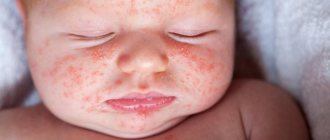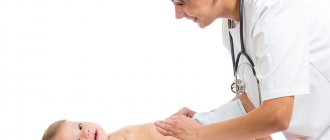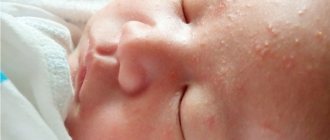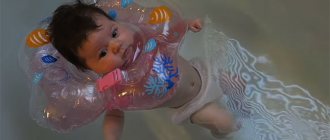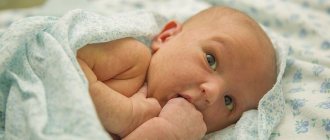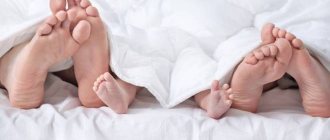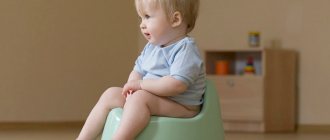The skin of a newborn baby is extremely sensitive and reacts to absolutely everything - allergens, external irritants, hormones. One of the types of manifestations on the skin of a baby is white pimples on different parts of the body.
A woman’s life completely changes with the birth of a child, and, in addition to joy, the fair half of humanity is faced with a number of issues regarding the baby’s health. One of them is the appearance of pimples in the baby. It is not always possible to immediately figure out what caused the rash - the mother’s diet and an allergic reaction, or physiological processes in the developing and fragile body of the newborn.
Small white pimples in newborns and infants
- One of the types of rashes on the baby’s body are white pimples on different parts of the child’s body. It’s not for nothing that there is a lot of discussion about rashes on a child’s body, because often rashes are a sign of a health problem
- If white pimples appear, there is no need to panic - often this is just an echo of the physiological processes that occur in the child’s body
- Such manifestations do not bother the child, and are also absolutely safe for his health and skin. They do not cause itching and do not become inflamed, therefore, they do not leave behind scars or marks.
White pimples in a newborn
Allergic rash in a newborn
The cause of such rashes is exposure to a provoking factor, which may be a food allergen, household chemicals, or skin care cosmetics. In addition, external irritants cannot be excluded from household, natural, or chemical origin. In all cases, the rash in infants looks the same and causes itching, burning, internal discomfort, and emotional instability. This unpleasant symptom characterizes several diseases presented below, so differential diagnosis is required. So:
- Food allergies. More often it appears on children's cheeks due to the penetration of the allergen into the digestive tract. The infection can enter the newborn's body through the mother's breast milk.
- Contact allergies, also called household allergies. Appears when the skin comes into direct contact with external allergens - potentially hazardous substances. The smell of paint or animal hair can provoke such an allergic reaction in a newborn.
- Drug allergy. A red rash becomes a side effect of long-term conservative treatment for a newborn and not only. Due to the weakening of the immune system by the disease, the newborn body is not able to resist partial intoxication of the body from the pills.
- Hives. This is a complicated form of an allergic reaction, in which the red rash is small and profuse. Prone to forming blisters. Externally, the rash resembles a nettle burn, hence the name. A complication for a newborn patient is anaphylactic shock, Quincke's edema.
- Prickly heat. The rash in a baby appears in the folds of the skin due to impaired sweating of these areas. The foci of pathology are the groin, back, armpits, and neck. The main task of parents is to restore the newborn’s heat exchange, dress the baby according to the weather, and remove the rash.
- Diaper dermatitis. Occurs upon contact with wet diapers, since liquid feces and urine irritate sensitive skin. First, irritation appears, and then diaper rash and sores appear. Parents need to follow the rules of personal hygiene for their newborn baby.
- Atopic dermatitis. A common skin disease that causes a blistering rash in a newborn. The foci of pathology are the cheeks and chin, legs and arms, and children’s buttocks. The rash itches and makes the newborn nervous and irritable.
Small white pimples in a newborn - causes
You may notice white pimples while still in the hospital, but sometimes they can appear 2-4 weeks after the baby is born. Everything is due to the causes of such rashes:
- Acne - the cause may lie in hormonal levels. This is how the mother’s hormones (extriol) manifest themselves in the child’s body or the hormonal changes in the baby’s body. If this type of acne appears, just keep your baby's skin dry and clean. Such pimples sometimes have a yellowish tint and appear in the face and neck; Activity of the sebaceous glands can also lead to acne. These pimples have a red base with a white tip in the center. It is recommended to take measures only in case of inflammation; in its absence, treatment is not required
- Milium - immaturity of the sebaceous glands - leads to the appearance of white pimples on the child's skin due to blockage of the sebaceous glands. They resemble small pearls the size of a pinhead and appear singly
Reasons for the formation of pimples
In newborns, rashes appear due to an excess of maternal hormones that the baby received in the womb. These pimples are commonly called neonatal acne and do not require any special treatment. You just need to follow basic hygiene rules, that is, keep your skin clean. The rashes are localized on the baby’s face and scalp.
In addition, pimples may appear due to improper functioning of the sebaceous glands. This is a temporary phenomenon; after a few weeks the rash will go away on its own.
The first two reasons for the appearance of pimples are quite natural and are associated with the fact that the child’s body adapts to new living conditions. But the appearance of a skin rash can be associated with a disease, as well as with improper care of the baby.
Acne may be caused by:
- Allergic reaction. Many babies develop rashes from using the wrong laundry detergent, not feeding the mother properly, or using the wrong formula.
- Prickly heat. Rashes occur if the child is wrapped up tightly. The sweat produced irritates the delicate skin, causing a rash to form.
- Dysbacteriosis. Poor digestion of food can affect the condition of the skin.
- Infectious diseases. Many diseases manifest themselves as pimples or blemishes on the skin.
Small white pimples on the face
- Small white pimples on the face most often occur due to incomplete functioning of the sebaceous glands. They pass as soon as the baby's ducts open. Most often this happens about a month after the appearance
- Such rashes do not require treatment. The main recommendation is to maintain hygiene for mother and child
- You need to not only wash your baby in the morning and evening, but also wipe (or better yet, wash) his face after each feeding to remove any remaining milk or formula. If you are breastfeeding, it is recommended to wash your breasts before and after feeding.
White pimples on the face
Non-infectious rashes
Herpes types 1 and 2
- Nature of the rash: individual watery pimples or grouped rash. At the beginning of the disease they are filled with clear liquid, after 1-2 days they are filled with pus. They open spontaneously, and in their place long-term non-healing wounds and crusts form. Pimples are painful and itchy.
- Location: most often in the mouth, genitals and lips, but can affect other areas.
- Additional symptoms: fever, headache, inflammation of the lymph nodes, general malaise.
- Treatment: antiviral drugs, antihistamines and antipyretics.
Shingles
- The nature of the rash: a group of bubbles with transparent contents, which become cloudy on the 3-4th day. Accompanied by severe burning and pain in the affected areas. Crusts form within 2-3 weeks.
- Localization: nerve nodes on the face and head, back, back of the head, shoulders, neck, arms and legs.
- Additional symptoms: headache, temperature up to 39 degrees, disruption of the gastrointestinal tract, inflammation of the lymph nodes, weakness.
- Treatment: antiviral drugs, antihistamines and antipyretics.
Chicken pox
- Character of the rash: small blisters filled with light liquid. They itch a lot. They burst quickly and a small wound appears in their place.
- Localization: throughout the body.
- Additional symptoms: fever, rarely – cough.
- Treatment: the blisters are treated with an antiseptic and antiallergic medications are prescribed.
Streptoderma
- Nature of the rash: purulent spots or blisters up to 10 centimeters. The rash causes burning and itching.
- Localization: first on the face, then spread throughout the body.
- Additional symptoms: intoxication of the body, temperature up to 38-39 degrees, lymphadenitis.
- Treatment: antibacterial ointments, antibiotics, antipyretic drugs, hypoallergenic diet, treatment of the rash with brilliant green, boric alcohol.
Enterovirus
- Nature of the rash: blistering rash with clear liquid.
- Localization: on different parts of the body and mucous membranes.
- Additional symptoms: headache, nausea, vomiting, fever.
- Treatment: immunomodulators, antibiotics, drugs aimed at eliminating symptoms.
Pemphigus
- Character of the rash: transparent watery blisters with a red rim.
- Localization: at the beginning of the disease - in the oral cavity, then - arms, legs, abdomen.
- Additional symptoms: weakness, elevated body temperature.
- Treatment: antiviral drugs, glucocorticosteroids, antihistamines, antipyretic drugs.
Felinosis
- Character of the rash: blisters with a small crust. Appear at the site of infection.
- Localization: at the site of cat scratches.
- Additional symptoms: inflammation of the lymph nodes, intoxication of the body.
- Treatment: anti-inflammatory and antibacterial agents, antiallergic drugs.
Watery pimples can be caused by parasite infestation. The blistering rash on the stomach, feet and between the fingers and toes is caused by the scabies mite. The rash is very itchy, especially at night. The blisters turn into pink spots a few days after they appear. The disease is treated with external agents (for example, benzyl benzoate ointment) and antihistamines.
Foot fungus can appear as small, watery blisters on the feet and heels. A fungal infection can enter the body when visiting public swimming pools or the gym. It is often accompanied by itching and flaking of the skin. An infection on the leg is treated with antifungal ointments and gels, and sometimes tablets are used.
- Small watery pimples in newborns and infants are caused by prickly heat. It occurs as a result of overheating and improper care of the baby's skin. At older ages, this phenomenon occurs less frequently. Miliaria is eliminated with the help of drying agents (decoctions of medicinal plants, powders, ointments).
- Allergic blistering rash is accompanied by swelling, itching, redness and peeling of the skin. The disease can be caused by food, household chemicals, cosmetics and medications. A distinctive feature of an allergic rash is that it disappears after the cause of the rash is eliminated. Allergies are treated with antihistamines.
White pimple on eyelid
Infants often develop white pimples on the upper or lower eyelid. These are milia or so-called millet. The main reasons for their appearance on the eyelid:
- Reaction to allergens
- Rarely, this is a consequence of prolonged exposure to ultraviolet radiation.
- Calcium deficiency (for example, when teething)
- Blockage of the sebaceous gland ducts
Important: In case of pimples on the eyelids, the main treatment is hygiene, but it is worth determining the cause of their appearance.
Pimple on the eyelid
Causes of acne in children
If the newborn is not yet 1 year old and is feeding on mother’s milk, then the cause of the rash should be looked for in the mother’s diet. When an acnemorphic rash appears in a baby, it can be assumed that during pregnancy, the pregnant mother was treated with steroids, medications containing lithium or phenytoin.
- Teeth are being cut. Against the background of profuse drooling, pimples are likely to form on the chin and chest;
- The skin overheats and diaper rash (miliaria or miliaria) appears in its folds. Rashes appear on the body and face in a hot room or too warm clothes made of low-quality artificial materials;
- The skin of young children often reacts to the vaccine;
- Change of weather. Especially in direct sunlight and frost in windy weather;
- Allergic reactions;
- Bites from mosquitoes, lice, dust fleas and bedbugs also cause rashes;
- Infectious diseases;
- Failure to comply with hygiene rules.
Basic rules of hygiene must be applied to children from birth. In the first years of life, the mother is responsible for this process, but starting from 2-3 years of age, children need to be taught to independently perform hygiene procedures.
White pimples on the genitals
Sometimes milia appear on the labia or on the penis of infants. This is also explained by blockage of the sebaceous glands and goes away with the normalization of their work. To prevent their occurrence, monitor your baby’s intimate hygiene:
- Wash after bowel movements in warm water. You can do this under the tap, placing the baby's tummy in the palm of your hand. With your free hand, wash from the pubis to the anus so as not to provoke an inflammatory process. This is especially true for girls
- Change diapers or nappies promptly
- Do not keep your baby in diapers all the time, give him air baths so that the skin can breathe
Important: If white pimples appear on your baby’s genitals, be sure to show him or her to a pediatrician or dermatologist. Sometimes they indicate the presence of a disease. For example, mycoplasmosis, a urogenital infection, can manifest itself this way.
Help a child
Prickly heat
The main remedy is to ensure a comfortable temperature in the room and proper hygienic care of the newborn’s skin. The baby should not be wrapped or overheated; daily air baths should be provided and the skin should be allowed to breathe without clothing or diapers.
When pimples appear, you can use special antibacterial ointments for babies (Bepanten, Desitin), powders, talc, which dry out the skin and eliminate diaper rash.
It is recommended to bathe in water with the addition of decoctions of herbs that have an antiseptic effect: chamomile, celandine, string, St. John's wort. If, after using the above remedies, prickly heat does not go away, you should consult a dermatologist, since a complication with the addition of a bacterial infection is possible. In this case, the doctor may prescribe antibacterial, immunomodulatory and antihistamine medications.
Allergic rashes
If you have allergic skin reactions, you should choose care products more carefully. It is recommended to wash laundry with laundry soap or special detergents for washing children's clothes. Cosmetics should be natural and hypoallergenic, clothing and bedding should be made from natural, breathable fabrics.
Pustules
It is necessary to constantly monitor the condition of the baby’s skin and, in case of the slightest damage or accidental scratches, treat them with antiseptic agents, constantly iron the clothes, and regularly wash the toys under hot boiled water.
Psoriasis
Due to the fact that this disease has not been fully studied, it is impossible to completely cure it. However, proper care and therapy can alleviate the condition and cope with painful symptoms in the acute period. First of all, the doctor prescribes medications that moisturize the affected areas of the skin (Vaseline, Hydrocortisone, Flucinar ointments). At the same time, immunostrengthening agents are prescribed (complex vitamins, which include vitamins A, C, B, PP), and physical therapy is also carried out.
White pimples on the gums and tongue
- Often appear simultaneously with pimples on the eyelids due to incompletely formed sebaceous glands.
- May be the result of stomatitis due to untreated feeding utensils or pacifiers. Stomatitis can also appear due to numerous kisses from the baby.
- If, in addition to pimples on the gums and tongue, you notice their appearance on the palate of a newborn, they may be a symptom of dysbiosis
- Bon's nodules on the gums are small cysts that look like pearls. They pose no danger and disappear without a trace over time.
- Teeth - neonatal (congenital) teeth. They can be included in a set of baby teeth or be extra in a row. In the second case, they need to be removed, so you need to consult a dentist
- Thrush - differs from other types of pimples by the manifestation of other symptoms: rising temperature, child anxiety, increase in the number of pimples
White pimple on the gum
Herpes
The virus is usually passed on to a child from an affected parent and can affect any part of the body. But most often, transparent pimples appear on the face of a newborn, usually in the lip area. The rash is accompanied by burning and itching.
Body temperature rises. After opening the blisters, ulcers remain on the skin. Sometimes the cervical lymph nodes become inflamed. If pathology occurs, antiviral agents are prescribed in the form of ointments, tablets, and injections. Antipyretic and immunostimulating drugs are also used.
How to treat white pimples?
- White pimples do not require special treatment. In this case, the so-called “policy of non-intervention” will be much more useful, when you want to treat, but you shouldn’t do it
- Do not squeeze pimples under any circumstances, you may cause an infection or provoke an inflammatory process.
- Do not rub your baby’s delicate skin with all kinds of alcohol-containing lotions and creams.
- Wash your newborn or baby with boiled water
- You can bathe your child in a weak, barely pink solution of potassium permanganate - this will help dry the skin
- Brew chamomile or string for bathing. Be careful - some babies may be allergic to some types of herbs
- It is recommended to give the baby air baths more often, if the room temperature allows
- Change clothes and diapers on time
- If you are breastfeeding, try to stick to your diet, do not eat red foods or citrus fruits. Excess sweets can also lead to breakouts
Important: If you follow all the recommendations, and pimples do not go away, consult your pediatrician and dermatologist. Sometimes white pimples can be a symptom of a disease
When to see a doctor
If you are concerned about your baby's complexion or if you are concerned that the condition is not improving after three to four months, consult your pediatrician. Your doctor may prescribe a special cream to treat acne in a newborn. Do not use over-the-counter creams or any other medications for acne without first consulting your pediatrician as they may harm your baby. Contact your pediatrician if your newborn has any of these symptoms:
- blisters on the skin
- peeling skin
- heat
- uncharacteristic tearfulness
- poor appetite
